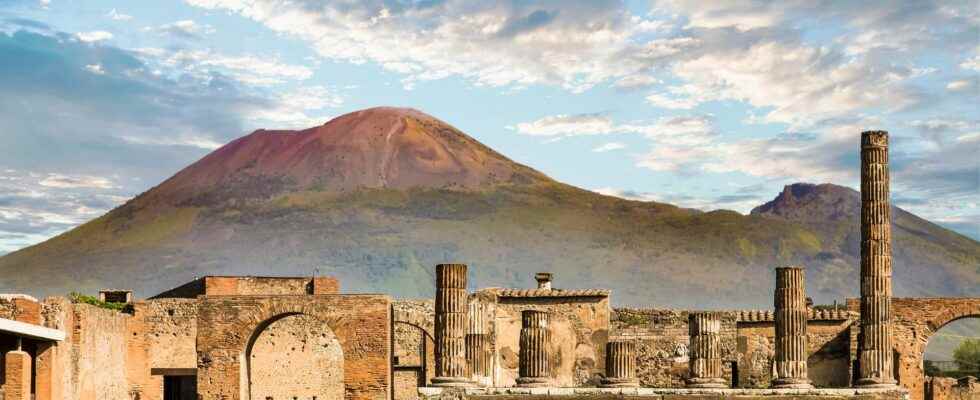You will also be interested
[EN VIDÉO] Archaeology: the bodies of two men excavated north of Pompeii Excavations carried out at the beginning of the year in Pompeii revealed two new victims of Vesuvius’ past wrath. Discover the images of the work carried out by the archaeologists on site. © Pompeii Sites
The eruption of Mount Vesuvius in the year 79 caused a terrible human tragedy by petrifying the whole region around the volcano, especially the city of Pompeii. Based on the famous letter sent by Pliny the Younger to his friend Tacitus, scientists have long been able to determine the date of this disaster. The young Roman, who was then in the Bay of Naples, witnessed the eruption of Vesuvius live. In his letter, he describes in detail all the geological phenomena that preceded the eruption (earthquake, ash plumes) and then the eruption itself. His uncle Pliny the Elderwhom he accompanied, will also be one of the victims of the disaster.
According to the medieval translations which have come down to us, the young man thus dates the beginning of the eruption nine days before the calends of September (nonum kal. septembers), i.e. August 24 in the morning.
Many clues that do not match with an eruption in August
This letter, the original of which has unfortunately disappeared, is the only clue that has come down to us to date the eruption historically. Although this date has long been widely accepted, several archaeological studies have however revealed many inconsistencies, suggesting that the city of Pompeii would have been buried two or even three months later. In effect, some of the petrified bodies found at the site appeared to be wearing warm clothing. Leftovers of wood burned in fireplaces also assume that the temperatures were not those of August. Similarly, the fruits found in the various shops and preserved using ashes are typical fruits of October : figs, pomegranatesolives… Even more disturbing, a coin found on the site of Pompeii commemorates the fifteenth acclamation of Emperor Titus, which corresponds to September 8 of the year 79. A graffitifound on the wall of a house, also mentions October 17, although the year is not given. Everything therefore suggests that the eruption would not have taken place at the end of the summer, but in fall and more precisely between October 17 and the 1er November 79.
Almost two thousand years after this terrible eruption, a multidisciplinary team has therefore looked again at the various traces left by this event with the aim of better characterizing it and, if possible, dating it precisely. A large amount of data has thus been compiled: historical, stratigraphic, sedimentological, petrological, geophysical, paleoclimatic and modeling data.
An event backdated by the copyist monks?
The results, published in Earth-Science Reviews, thus demonstrate that the eruption would not have actually taken place on August 24 but most certainly on October 24-25. This new date indeed corroborates the very numerous information provided by archaeology, the year 79 being validated by the isotopic dating of volcanic deposits. According to the stratospheric circulation model, the study of the direction of winds at the time of the eruption also supports the idea of an eruption in autumn rather than summer.
Could Pliny the Younger have the date wrong? This is unlikely. The error could rather come from the oldest translation of the letter of Pliny the Younger and which was used as a reference. This translation dates back to the IXe century. However, at that time, it was common for monk copyists to change the dates of major historical events to make them coincide with certain religious or cultural stories.
The authors of the study offer a hypothesis, noting that the date of August 24 corresponds to an ancient Roman ritual, the ” Vulcanalia “. On that day, the souls of the dead came to the surface thanks to the opening of a “connection” between the underworld and the world of the living. Every year on August 24, the Romans moved the stone sealing this passage, letting souls spill out into the city. The stone was replaced three days later. This ritual would certainly have represented a analogy perfect for eyes copyist monks to explain the “opening” of the crater of Vesuvius, which was considered in the Middle Ages as the passage to Hell.
Understanding the course of the eruption of 79 to better assess the current risk
The dating of the event was not the only objective of this study. One of the fundamental points was to better understand the different phases of the eruption in order to prepare the region for a new disaster of the same kind, Vesuvius is still an active volcano. The volcanic risk is indeed very real and particularly high for this very densely populated region. The study also shows that the eruption had an impact on a very large area, volcanic deposits having been found as far as Greece.
Interested in what you just read?
